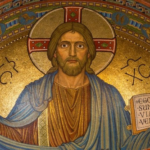We run our website the way we wished the whole internet worked: we provide high quality original content with no ads. We are funded solely by your direct support. Please consider supporting this project.

Why Did Jesus Die on the Cross?
If asked why Jesus had to die on the cross, most Christians today would immediately answer, “To pay for my sins.” Jesus certainly paid the price for our sins, but it might surprise some reader to learn that this wasn’t the way Christians would answer this question for the first thousand years of Church history. The main reason Jesus died on the cross, according to this earlier view, was to defeat Satan and set us free from his oppressive rule. Everything else that Jesus accomplished, including paying for our sins, was to be understood as an aspect and consequence of this victory.
This earlier understanding of why Jesus had to die is called the Christus Victor (Latin for “Christ is Victorious”) view of the atonement. In my estimation it captures the profound beauty of the New Testament account better than the view that focuses exclusively on what Jesus did for us.
The Christus Victor motif is strongly emphasized throughout the New Testament. Scripture declares that Jesus came into this world to “drive out the ruler of this world” (Jn 12:31), to “destroy the works of the devil” (I Jn 3:8), to “destroy the one who has the power of death, that is, the devil” (Heb. 2:14-15) and to ultimately “put all his enemies under his feet” (I Cor 15:25). Jesus came to overpower the “strong man” (Satan) who holds the world in bondage and to work with his children to “plunder his house” (Lk 11:21-22). He came to end the reign of the cosmic “thief” who seized the world to “steal and kill and destroy” the life God intended for us (Jn 10:10). Jesus came to earth and died on the cross to disarm “the rulers and authorities” and make a “public spectacle of them” by “triumphing over them on the cross” (Col 2:15).
Beyond these explicit statements, there are many other passages that express the Christus Victor motif as well. For example, the first prophecy in the Bible foretells that a descendent of Eve (Jesus) would crush the head of the serpent (Gen. 3:15). The first Christian sermon ever preached proclaims that Jesus in principle conquered all God’s enemies (Ac 2:32-36). And the single most frequently quoted Old Testament passage by New Testament authors is Psalm 110:1 which predicts that Christ would conquer all God’s opponents. (Pslams.110 is quoted or alluded to Mt 22:41-45; 26:64; Mk 12:35-37; 14:62; Lk 20:41-44; 22:69; Ac 5:31; 7:55-56; Rom 8:34; I Cor 15:22-25; Eph 1:20; Heb 1:3; 1:13; 5:6, 10; 6:20; 7:11, 15,17,21; 8:1; 10:12-13; I Pet 3:22; and Rev. 3:21) According to the great New Testament scholar Oscar Cullman, the frequency with which New Testament authors cite this Psalm is the greatest proof that Christ’s “victory over the angel powers stands at the very center of early Christian thought.”
The Incarnation of the Son of God fulfilled God’s original dream of uniting himself to humanity to acquire a bride and co-ruler. But it’s clear from the Christus Victor motif we’ve just examined that, because of our rebellion, the Incarnation also involved a rescue mission that included a strategy for vanquishing the powers of darkness.
Category: General
Tags: Atonement, Christus Victor, Crucifixion, Jesus, Penal Substitution View of Atonement, Satan, Warfare Worldview
Topics: Christus Victor view of Atonement
Related Reading

Uncrossed
Did any of you catch SNL this weekend? They did a parody of Tarantino’s DJango Unchained called DJesus Uncrossed. Many were deeply offended by the depiction of Jesus in this, but David R. Henson blogged about how this skit revealed what we’ve already been doing for quite a while as a culture. In his blog…

Jesus is the Center of the Story
The previous post addressed how the revelation of Christ is the surprising twist that reframes how we must read all that precedes it. Today we’ll look briefly at five supports to this claim. Jesus said, “I have a testimony greater than that of John” (John 5:36). Jesus elsewhere claims that “among those born of women…

The Politics of Jesus, Part 2
Even in the midst of politically-troubled times, we are called to preserve the radical uniqueness of the kingdom. This, after all, is what Jesus did as he engaged the first century world with a different kind of politics (see post). To appreciate the importance of preserving this distinction, we need to understand that the Jewish…

Jesus and the Reality of Spiritual Warfare
In yesterday’s post, we discussed how challenging it can be to believe in the reality of a spiritual realm in the modern world. Today, let’s look at how Jesus’ ministry relates to this spiritual reality. While Jesus and his followers of course believed that God was the ultimate Lord over all creation, they clearly viewed…

Why Did Jesus Cry Out that God Had Forsaken Him?
At the climax of Jesus’ suffering on the cross, Jesus cries out: “My God, my God, why have you forsaken me?” (Mt 27:46) It’s a jarring moment in the narrative. To forsake is to abandon. Did Jesus really believe that God had abandoned him? Was Jesus right about this? If he was right, what does…

Can You Hold a Cruciform Theology AND a Penal Substitution View of Atonement? (podcast)
If you view the cross as the outlet of God’s wrath, then the violence in the Old Testament seems to make perfect sense. Greg responds. Episode 614 http://traffic.libsyn.com/askgregboyd/Episode_0614.mp3
